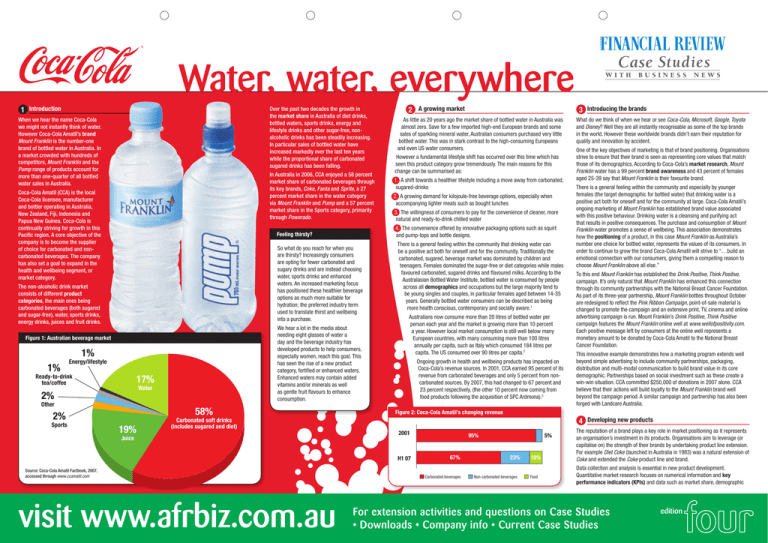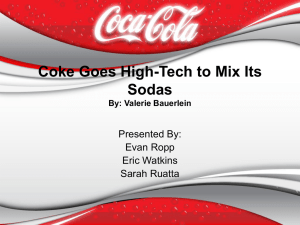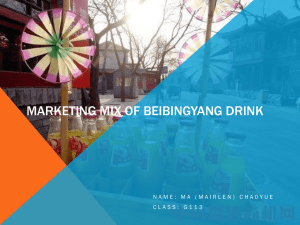Document 13248235
advertisement

Water, water, everywhere 1 Introduction Over the past two decades the growth in the market share in Australia of diet drinks, bottled waters, sports drinks, energy and lifestyle drinks and other sugar-free, nonalcoholic drinks has been steadily increasing. In particular sales of bottled water have increased markedly over the last ten years while the proportional share of carbonated sugared drinks has been falling. When we hear the name Coca-Cola we might not instantly think of water. However Coca-Cola Amatil’s brand Mount Franklin is the number-one brand of bottled water in Australia. In a market crowded with hundreds of competitors, Mount Franklin and the Pump range of products account for more than one-quarter of all bottled water sales in Australia. In Australia in 2006, CCA enjoyed a 58 percent market share of carbonated beverages through its key brands, Coke, Fanta and Sprite, a 27 percent market share in the water category via Mount Franklin and Pump and a 57 percent market share in the Sports category, primarily through Powerade. Coca-Cola Amatil (CCA) is the local Coca-Cola licensee, manufacturer and bottler operating in Australia, New Zealand, Fiji, Indonesia and Papua New Guinea. Coca-Cola is continually striving for growth in this Pacific region. A core objective of the company is to become the supplier of choice for carbonated and noncarbonated beverages. The company has also set a goal to expand in the health and wellbeing segment, or market category. So what do you reach for when you are thirsty? Increasingly consumers are opting for fewer carbonated and sugary drinks and are instead choosing water, sports drinks and enhanced waters. An increased marketing focus has positioned these healthier beverage options as much more suitable for hydration; the preferred industry term used to translate thirst and wellbeing into a purchase. We hear a lot in the media about needing eight glasses of water a day and the beverage industry has developed products to help consumers, especially women, reach this goal. This has seen the rise of a new product category, fortified or enhanced waters. Enhanced waters may contain added vitamins and/or minerals as well as gentle fruit flavours to enhance consumption. Figure 1: Australian beverage market 1% 1% Energy/lifestyle Ready-to-drink tea/coffee 17% Water 2% Other 58% 2% Sports 19% Carbonated soft drinks (includes sugared and diet) Juice As little as 20 years ago the market share of bottled water in Australia was almost zero. Save for a few imported high-end European brands and some sales of sparkling mineral water, Australian consumers purchased very little bottled water. This was in stark contrast to the high-consuming Europeans and even US water consumers. However a fundamental lifestyle shift has occurred over this time which has seen this product category grow tremendously. The main reasons for this change can be summarised as: 1. A shift towards a healthier lifestyle including a move away from carbonated, sugared-drinks 2. A growing demand for kilojoule-free beverage options, especially when accompanying lighter meals such as bought lunches 3. The willingness of consumers to pay for the convenience of cleaner, more natural and ready-to-drink chilled water There is a general feeling within the community that drinking water can be a positive act both for oneself and for the community. Traditionally the carbonated, sugared, beverage market was dominated by children and teenagers. Females dominated the sugar-free or diet categories while males favoured carbonated, sugared drinks and flavoured milks. According to the Australasian Bottled Water Institute, bottled water is consumed by people across all demographics and occupations but the large majority tend to be young singles and couples, in particular females aged between 14-35 years. Generally bottled water consumers can be described as being more health conscious, contemporary and socially aware.1 Australians now consume more than 20 litres of bottled water per person each year and the market is growing more than 10 percent a year. However local market consumption is still well below many European countries, with many consuming more than 100 litres annually per capita, such as Italy which consumed 184 litres per capita. The US consumed over 90 litres per capita.2 Ongoing growth in health and wellbeing products has impacted on Coca-Cola’s revenue sources. In 2001, CCA earned 95 percent of its revenue from carbonated beverages and only 5 percent from noncarbonated sources. By 2007, this had changed to 67 percent and 23 percent respectively, (the other 10 percent now coming from food products following the acquisition of SPC Ardmona).3 visit www.afrbiz.com.au What do we think of when we hear or see Coca-Cola, Microsoft, Google, Toyota and Disney? Well they are all instantly recognisable as some of the top brands in the world. However these worldwide brands didn’t earn their reputation for quality and innovation by accident. One of the key objectives of marketing is that of brand positioning. Organisations strive to ensure that their brand is seen as representing core values that match those of its demographics. According to Coca-Cola’s market research, Mount Franklin water has a 99 percent brand awareness and 43 percent of females aged 25-39 say that Mount Franklin is their favourite brand. There is a general feeling within the community and especially by younger females (the target demographic for bottled water) that drinking water is a positive act both for oneself and for the community at large. Coca-Cola Amatil’s ongoing marketing of Mount Franklin has established brand value associated with this positive behaviour. Drinking water is a cleansing and purifying act that results in positive consequences. The purchase and consumption of Mount Franklin water promotes a sense of wellbeing. This association demonstrates how the positioning of a product, in this case Mount Franklin as Australia’s number one choice for bottled water, represents the values of its consumers. In order to continue to grow the brand Coca-Cola Amatil will strive to “…build an emotional connection with our consumers, giving them a compelling reason to choose Mount Franklin above all else.” To this end Mount Franklin has established the Drink Positive, Think Positive, campaign. It’s only natural that Mount Franklin has enhanced this connection through its community partnerships with the National Breast Cancer Foundation. As part of its three-year partnership, Mount Franklin bottles throughout October are redesigned to reflect the Pink Ribbon Campaign, point-of-sale material is changed to promote the campaign and an extensive print, TV, cinema and online advertising campaign is run. Mount Franklin’s Drink Positive, Think Positive campaign features the Mount Franklin online well at www.wellofpositivity.com. Each positive message left by consumers at the online well represents a monetary amount to be donated by Coca-Cola Amatil to the National Breast Cancer Foundation. This innovative example demonstrates how a marketing program extends well beyond simple advertising to include community partnerships, packaging, distribution and multi-modal communication to build brand value in its core demographic. Partnerships based on social investment such as these create a win-win situation. CCA committed $250,000 of donations in 2007 alone. CCA believe that their actions will build loyalty to the Mount Franklin brand well beyond the campaign period. A similar campaign and partnership has also been forged with Landcare Australia. Figure 2: Coca-Cola Amatil’s changing revenue 4 Developing new products 2001 H1 07 Source: Coca-Cola Amatil Factbook, 2007, accessed through www.ccamatil.com 3 Introducing the brands 4. The convenience offered by innovative packaging options such as squirt and pump-tops and bottle designs. Feeling thirsty? The non-alcoholic drink market consists of different product categories, the main ones being carbonated beverages (both sugared and sugar-free), water, sports drinks, energy drinks, juices and fruit drinks. 2 A growing market 95% 67% Carbonated beverages 5% 23% Non-carbonated beverages 10% Food The reputation of a brand plays a key role in market positioning as it represents an organisation’s investment in its products. Organisations aim to leverage (or capitalise on) the strength of their brands by undertaking product line extension. For example Diet Coke (launched in Australia in 1983) was a natural extension of Coke and extended the Coke product line and brand. Data collection and analysis is essential in new product development. Quantitative market research focuses on numerical information and key performance indicators (KPIs) and data such as market share, demographic For extension activities and questions on Case Studies • Downloads • Company info • Current Case Studies edition As part of its ongoing operations CCA has identified three main environmental objectives; sustainable water management, efficient energy use and a reduction in packaging and post-consumer waste. Sustainable water management There is ongoing concern at the environmental costs arising from the packaging and distribution of bottled water. Critics argue that the unnecessary transport of water leads to increased carbon emissions. The water used in CCA’s bottled water products is sourced locally - from within around two hours’ drive of their production plants. The bulk of their water is purchased at market rates from small businesses or farmers. Sourcing water locally means minimal environmental negatives, such as carbon emissions that come from unnecessary transportation of water. Research and development in the bottled water market has seen the emergence of enhanced waters, which are based on adding natural flavours and/or vitamins and minerals to still water to enhance hydration. Enhanced waters are positioned somewhere between sports-drinks (which are primarily male-orientated) and still waters. It’s only natural that an organisation such as Coca-Cola has tapped into the needs of this growing wellbeing market, with water that has enhanced flavour. Coca-Cola’s Pump is positioned for the modern, active consumer. Its convenient squeezy bottle makes it an ideal choice for on-the-go hydration. Reduction in post-consumer waste CCA are partnering with key customers as part of the Refresh, Recycle, Renew program to implement public place recycling at venues such as theme parks, shopping centres and public events. Through further research and development, Coca-Cola is also working to ensure that packaging requires less glass and PET plastic. In 2007, over 25 million kilograms of plastic will be eliminated through packaging redesigns.5 6 Conclusion One of the most consistent growth segments in the non-alcoholic beverage market is bottled water. This growth is particularly evident among women under 40 and with younger, ‘urban’ consumers. The potential for further growth in the market has extended to enhanced waters and other health and wellbeing products. Australia lags behind most of the developed world in the consumption of bottled waters, but organisations such as Coca-Cola have extended their product lines to create opportunities for increased sales. As the Australian market leader in bottled water, Coca-Cola has striven to be a responsible corporate citizen, balancing triple-bottom line objectives of market success, environmental sustainability and social enterprise. Urban innovation Coca-Cola has also created a strong association for Pump with the dance music community through sponsorship of dance festivals and music downloads. As part of its innovative marketing of Pump in 2007, Australian consumers were able to download a special version of Evermore’s, Running, mixed by Sneaky Sound System. Using Hypertag technology, consumers were able to download the digital track via Bluetooth within a 5-metre radius of special Pump ads located in high footfall urban areas. Brand The trading name of a product that has a high level of recognition in the market place. Successful development of the brand and ‘brand mark’ (identifying symbols and design) is a considerable marketing tool. Demographics The specific characteristics of the target audience. It includes variables like age, income, gender and occupation. Key performance indicators (KPIs) Specific criteria used to measure how efficient and effective a business has been in achieving strategic goals. CCA has installed a range of energy saving devices, resulting in electricity consumption for lighting declining by 30 to 40 percent. CCA expects energy saving programs to reduce greenhouse gas emissions by more than 2,000 tonnes of carbon dioxide a year. CCA is also a significant user of Green Power.4 Coca-Cola launched Pumped Lemon, Pumped Mandarin and Pumped Lime to capitalise on the brand strength of Pump. After extensive product testing, these gently flavoured enhanced waters were launched to cater for the growing sophistication of the active 20-30 year-old water consumer. Brand awareness The profile that a particular product has with consumers in the market. Advertising can enhance brand awareness. Focus group A qualitative market research technique in which a group of participants (approximately 10) of common demographics, attitudes, or purchase patterns are led through a discussion of a particular topic by a trained moderator. Efficient energy use Measures such as increased efficiencies in water use, less waste in plant operations and harvesting rain water (at Northmead and Eastern Creek) have helped CCA to maintain world’s-best practice in the global Coca-Cola system, with just 1.55 litres of water used per litre of product in Australia. CCA and Coca-Cola have embarked on a multi-varied marketing campaign that extends well beyond traditional advertising and distribution channels. The successful ongoing marketing of Mount Franklin and Pump incorporates media advertising, community partnerships, innovative packaging design and interactive digital engagement through the Internet and new media channels. GLOSSARY Market research Finding out information about the characteristics of potential customers to solve marketing problems and help with marketing decisions. Market share The proportion of the total market of a product or service that is held by an individual business. Usually expressed as a percentage. Positioning The combined marketing strategies that result in how the organisation wants a product or brand to be perceived by the market. Positioning is directly related to brand values, market demographics and the image of the product in the marketplace. Product categories The generic term that is accepted industry-wide to describe a group or sub-group of similar products. Triple-bottom line Organisations operating responsibly to achieve economic objectives such as market success, environmental objectives such as sustainability and social objectives. 1 (Source: The Australian Bottled Water Institute 2004, Bottled Water, http://www.bottledwater.org.au/ scripts/cgiip.exe/WService=ASP0003/ccms.r?PageId=5002 , viewed 28/March, 2008). 2 (Source: Beverage Marketing Corporation, cited in John G. Rodwan, Jr., “Bottled Water 2004: U.S. and International Statistics and Developments,” Bottled Water Reporter, April/May 2005.) 3 (Source: Coca-Cola Amatil Fact Book, 2007). 4 The Coca-Cola Company Climate-Energy Fact Sheet. 5 The Coca-Cola Company and Bottled water Fact Sheet 4.22. Questions and Extension Activities for Coca-Cola are on www.afrbiz.com.au You will also find links to the Coca-Cola website 'Coca-Cola', 'Coke' and 'Pump' are registered trade marks of The Coca-Cola Company. 'Mount Franklin' is a registered trade mark of Coca-Cola Amatil. visit www.afrbiz.com.au For extension activities and questions on Case Studies • Downloads • Company info • Current Case Studies edition The Australian Financial Review and ©Australian Business Case Studies Pty Ltd. Whilst every effort has been made to ensure accuracy of information, neither the publisher nor the client can be held responsible for errors or omissions in this Case Study. 5 Ensuring sustainability targeting (Pump is primarily consumed by 20-30 year-olds) and sales growth (sales of Pump waters grew 35 percent in the first quarter of 2007). Qualitative market research relies on feedback through focus groups, new product testing and trials and web-based feedback.






